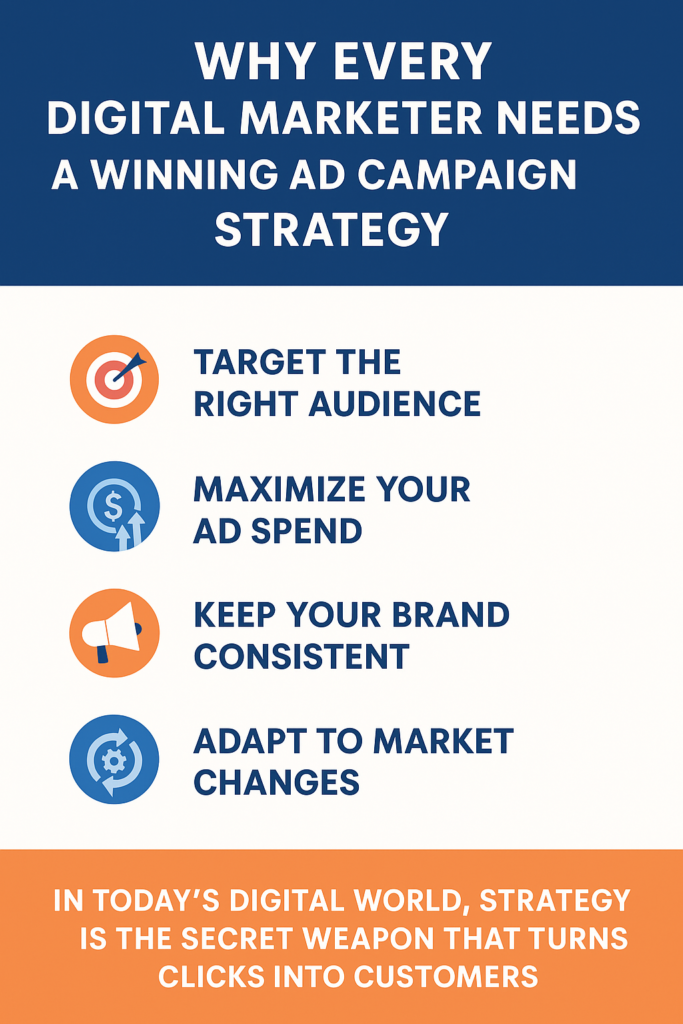
In today’s hyper-competitive online marketplace, digital marketing is not just about posting content and hoping for engagement. Brands are battling for attention in an environment where consumers are bombarded with thousands of messages daily. This is where a winning ad campaign strategy becomes a game-changer.A well-executed ad campaign does more than generate clicks—it builds brand awareness, drives targeted traffic, boosts conversions, and maximizes ROI. Whether you’re running ads on Google, Facebook, Instagram, LinkedIn, or TikTok, the key to success lies in having a structured, goal-driven approach.In this comprehensive guide, we’ll explore at Digitalents Academy as we are one of the best digital marketing institute in Bangalore,why digital marketer needs a winning ad campaign strategy, what it entails, and how you can craft one that consistently delivers results.
1. Understanding the Role of Ad Campaigns in Digital Marketing
An ad campaign is a series of coordinated advertisements designed to achieve a specific marketing goal. This goal might be increasing brand awareness, generating leads, driving sales, or promoting a specific offer or event.
Ad campaigns are powerful because they:
- Target the right audience through demographic, geographic, and behavioral filters.
- Deliver measurable results with data-driven insights.
- Enhance brand recall by consistently presenting the brand message. Increase revenue potential by connecting with high-intent buyers.
Without a clear ad strategy, even the most creative ads can get lost in the noise.
2. Why a Winning Ad Campaign Strategy is Essential
A winning strategy ensures your ads work smarter, not harder. It minimizes wasted budget, improves targeting accuracy, and ensures your marketing message reaches the right people at the right time.
Here’s why having a strong strategy is non-negotiable:
- Budget Efficiency: Prevents spending money on irrelevant clicks or impressions.
- Consistent Branding: Keeps your brand message uniform across all channels.
- Higher ROI: Maximizes returns by targeting high-value customers.
- Scalable Growth: Makes it easier to replicate success for future campaigns.
3. Setting Clear Campaign Objectives
Every winning ad campaign begins with clear, measurable objectives. The most common goals include:
- Brand Awareness – Reaching a larger audience to build recognition.
- Lead Generation – Collecting contact details for future marketing efforts.
- Sales Conversion – Turning potential leads into paying customers.
- Customer Retention – Re-engaging existing customers with offers and updates.
Using the SMART framework — Specific, Measurable, Achievable, Relevant, Time-bound — ensures your goals are realistic and trackable.
4. Knowing Your Target Audience
Your campaign’s success hinges on audience targeting. Before launching, ask yourself:
- Who is my ideal customer?
- What are their pain points?
- Which platforms do they use most?
- What motivates them to take action?
Leverage tools like Google Analytics, Facebook Audience Insights, and customer surveys to create detailed buyer personas. This ensures your ads speak directly to the right people.
5. Choosing the Right Advertising Platforms
Not all platforms are created equal. Each one serves different demographics and marketing objectives:
- Google Ads – Best for targeting active search intent.
- Instagram Ads and Facebook – Ideal for brand awareness and storytelling.
- LinkedIn Ads—Perfect for B2B lead generation.
- TikTok Ads—Great for younger audiences and viral engagement.
- YouTube Ads – Excellent for video-driven campaigns and product demos.
A winning strategy often uses a multi-channel approach to maximize reach.
6. Crafting Compelling Ad Creatives
The creative aspect of your ads—images, videos, headlines, and copy—determines whether users engage or scroll past. Effective creatives should be:
- Eye-catching to grab attention instantly.
- Emotion-driven to connect with viewers.
- Clear and concise in delivering the message.
- Action-oriented with strong CTAs (Call-to-Actions).
Example: Instead of “Buy Now,” try “Get 50% Off – Today Only!” to create urgency
7. Leveraging Data and Analytics
In digital marketing, data is gold. Successful ad campaigns rely on continuous tracking and optimization. Key metrics to monitor include:
- Click-Through Rate (CTR) – Measures ad engagement.
- Conversion Rate (CR) – Shows how many clicks turn into leads or sales.
- Cost Per Click (CPC) – Indicates ad cost efficiency.
- Return on Ad Spend (ROAS) – Reveals overall profitability.
By analyzing performance data, you can make data-driven adjustments to improve results.
8. A/B Testing for Better Results
A/B testing involves running two versions of an ad to see which performs better. You might test:
- Headlines
- Images or videos
- CTA buttons
- Targeting parameters
Even a slight adjustment can lead to substantial improvements in conversion rates.
9. Retargeting for Higher Conversions
Not all users convert on their first interaction with your brand. That’s where retargeting campaigns come in — showing ads to people who have already visited your website or engaged with your content.
Benefits of retargeting:
- Keeps your brand top-of-mind.
- Encourages users to complete abandoned purchases.
- Boosts overall conversion rates.
Platforms like Facebook Pixel and Google Remarketing make retargeting easy to implement.
10. Budget Management and Bidding Strategies
Your budget allocation determines the scale and reach of your campaign. Use strategies like:
- Cost-Per-Click (CPC)—Pay only when users click your ad.
- Cost-Per-Mille (CPM)—Pay per thousand impressions.
- Cost-Per-Acquisition (CPA)—Pay when a user takes a desired action.
Monitoring and adjusting bids ensures you maximize ROI without overspending.
11. Staying Ahead with Trends and Technology
Digital marketing evolves rapidly. Emerging trends like AI-powered targeting, influencer collaborations, and interactive ads can give your campaigns a competitive edge.
Stay updated with:
- Industry blogs
- Webinars and conferences
- Platform updates and algorithm changes
Conclusion
A winning ad campaign strategy is not just a marketing luxury—it’s a necessity in today’s digital age. From setting clear objectives to mastering targeting, creatives, and analytics, every step plays a critical role in ensuring your ads deliver maximum impact.
When executed correctly, ad campaigns can turn casual browsers into loyal customers, strengthen your brand presence, and dramatically boost your bottom line.
If you’re a digital marketer aiming for consistent growth, investing in a strong ad strategy
